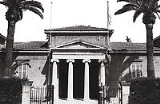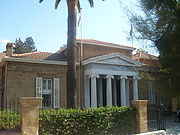
Cyprus Museum
Encyclopedia

Museum
A museum is an institution that cares for a collection of artifacts and other objects of scientific, artistic, cultural, or historical importance and makes them available for public viewing through exhibits that may be permanent or temporary. Most large museums are located in major cities...
in Cyprus
Cyprus
Cyprus , officially the Republic of Cyprus , is a Eurasian island country, member of the European Union, in the Eastern Mediterranean, east of Greece, south of Turkey, west of Syria and north of Egypt. It is the third largest island in the Mediterranean Sea.The earliest known human activity on the...
.
The museum houses artefacts discovered during numerous excavations on the island. The museum is home to the most extensive collection of Cypriot antiquities in the world and is located on Museum Street in central Nicosia
Nicosia
Nicosia from , known locally as Lefkosia , is the capital and largest city in Cyprus, as well as its main business center. Nicosia is the only divided capital in the world, with the southern and the northern portions divided by a Green Line...
. Its history goes hand in hand with the course of modern archaeology (and the Department of Antiquities) in Cyprus. Of note is that only artefacts discovered on the island are displayed.
History
As an institution, the Cyprus Museum was founded in 1882 during the BritishBritish people
The British are citizens of the United Kingdom, of the Isle of Man, any of the Channel Islands, or of any of the British overseas territories, and their descendants...
occupation of the island following a petition by the Cypriot people. The petition was delivered to the British administration by a delegation headed by the religious leaders of both the Christian
Christian
A Christian is a person who adheres to Christianity, an Abrahamic, monotheistic religion based on the life and teachings of Jesus of Nazareth as recorded in the Canonical gospels and the letters of the New Testament...
and Muslim
Muslim
A Muslim, also spelled Moslem, is an adherent of Islam, a monotheistic, Abrahamic religion based on the Quran, which Muslims consider the verbatim word of God as revealed to prophet Muhammad. "Muslim" is the Arabic term for "submitter" .Muslims believe that God is one and incomparable...
populations. A major catapult for this action were several illicit excavations and the smuggling of antiquities off the island. The most extensive of these had been carried out a few years earlier by the United States
United States
The United States of America is a federal constitutional republic comprising fifty states and a federal district...
Ambassador, Luigi Palma di Cesnola
Luigi Palma di Cesnola
Luigi Palma di Cesnola , an Italian-American soldier and amateur archaeologist, was born in Rivarolo Canavese, near Turin...
, who had smuggled over 35,000 artefacts off the island, most of which were destroyed in transit. Many of the surviving items ended up in the newly formed Metropolitan Museum of Art
Metropolitan Museum of Art
The Metropolitan Museum of Art is a renowned art museum in New York City. Its permanent collection contains more than two million works, divided into nineteen curatorial departments. The main building, located on the eastern edge of Central Park along Manhattan's Museum Mile, is one of the...
in New York
New York
New York is a state in the Northeastern region of the United States. It is the nation's third most populous state. New York is bordered by New Jersey and Pennsylvania to the south, and by Connecticut, Massachusetts and Vermont to the east...
and are on display to this date in the Greek and Roman Art galleries.
The initial museum was funded by private donations and was temporarily housed in existing governmental offices. It moved to its own premises in 1889 on Victoria Street within the medieval walls of the city. Construction of the current building began in 1908 and was originally dedicated to the memory of the British monarch, Queen Victoria. It was designed by the architect N. Balanos of the Archaeological Society of Athens
Archaeological Society of Athens
The Archaeological Society of Athens is an independent learned society. Also termed the Greek Archaeological Society, it was founded in 1837, just a few years after the establishment of the modern Greek State, with the aim of encouraging archaeological excavations, maintenance, care and exhibition...
and construction was supervised by George H. Everett Jeffery then curator of the museum. In 1961 a second set of galleries, storerooms and offices was completed.
Collections

Swedish Cyprus Expedition
The Swedish Cyprus Expedition was a project to systematically investigate the archaeology of the entire early history of Cyprus. It took place between September 1927 and March 1931 and was led by three archaeologists: Einar Gjerstad, Erik Sjöqvist and Alfred Westholm together with architect John...
between 1927 and 1931 under the direction of professor Einar Gjerstad
Einar Gjerstad
Einar Gjerstad was a Swedish archaeologist of the ancient Mediterranean, particularly known for his work on Cyprus, as well as his studies of early Rome....
.
Today, the Cyprus Museum remains the principal show-piece for finds preceding independence (1960). It also houses the most important recent acquisitions. Recent years have seen a progressive decentralization of Cyprus's museum collections and most finds from current excavations are deposited in the local district museums.
The museum consists of fourteen display halls surrounding a square central area which comprises auxiliary offices, a library, storerooms and laboratories for preserving and studying items in the collection. The displays in each hall follow a chronological and a thematical succession starting from the Neolithic
Neolithic
The Neolithic Age, Era, or Period, or New Stone Age, was a period in the development of human technology, beginning about 9500 BC in some parts of the Middle East, and later in other parts of the world. It is traditionally considered as the last part of the Stone Age...
period and ending with the Roman period.
Future
The museum collection has far outgrown the capacity of the existing buildings so much so that only a small fraction is on display at any point in time. With several ongoing excavations and constant new finds, the issue of relocation to more spacious premises has been raised but a suitable site has yet to be decided on. There have been suggestions that the nearby and now empty building of the Nicosia Old General HospitalNicosia Old General Hospital
Nicosia Old General Hospital was the main hospital of Nicosia, Cyprus from 1936 to 2006. In 2006, its patients were transferred to the Nicosia New General Hospital, and it was demolished in 2010 amidst some controversy over whether it should have been preserved.The decision for erecting a purpose...
be redeveloped, whilst there have also been plans to create a new museum as part of a new larger cultural centre at the site of the old GSP stadium.

